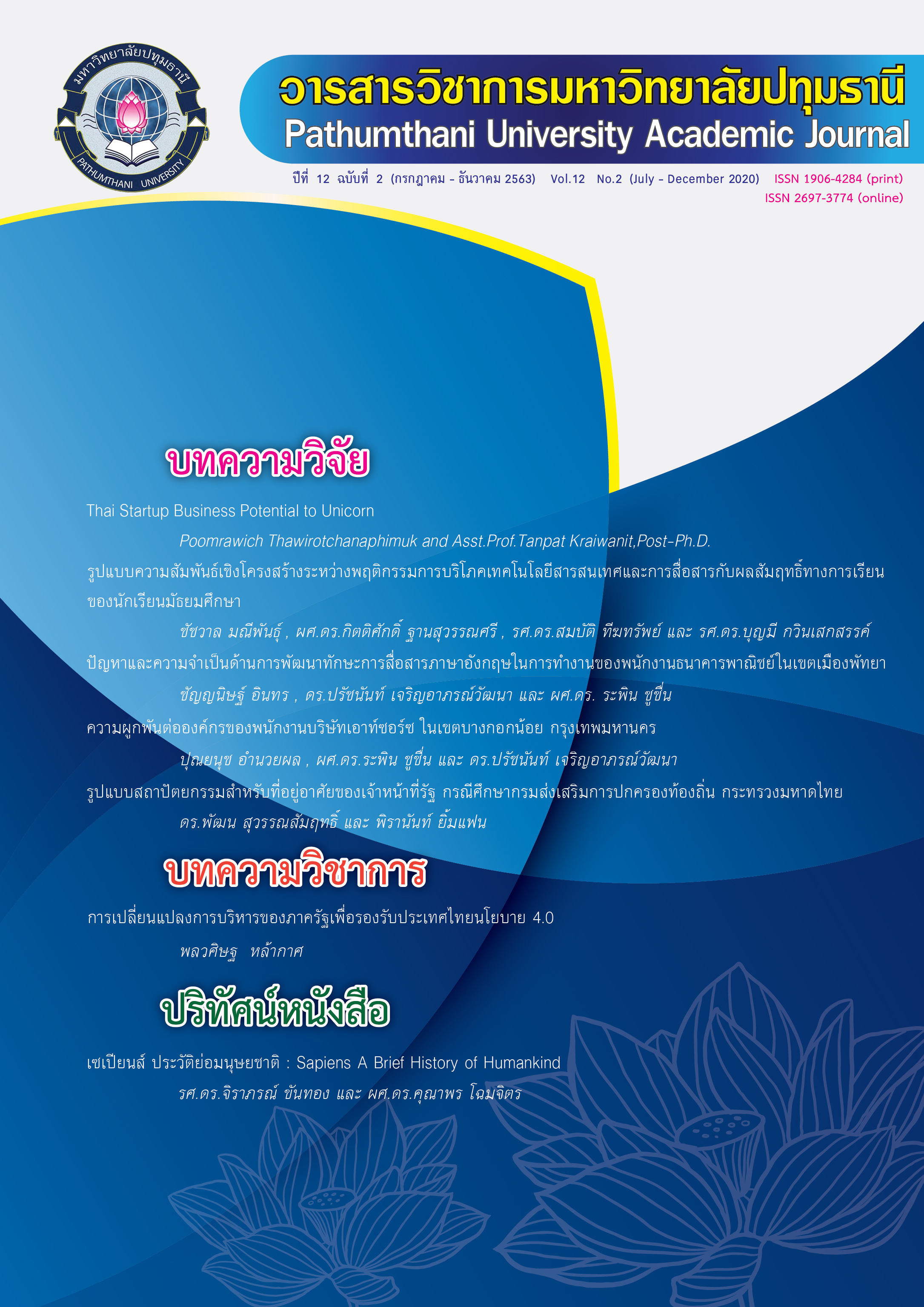FACTORS OF NOSTALGIA TOURISM POTENTIAL AND MARKETING MIX AFFECTING TO TOURISM BEHAVIOR: CASE STUDY OF TRADITIONAL MARKET IN SUPHANBURI PROVINCE
Keywords:
Service marketing mix, tourism potential, factors that cause longing for the past, tourism behaviorAbstract
In At present, the tourism industry has grown in Thailand. The traditional markets can be considered as a business that is called, The place of Nostalgia tourism. Which has received attention from the group Thai tourists, but during the year 2017, tourists have recognized there is a noticeable decrease in the number. Because communities and agencies may still lack continuous tourism development within the area and the strategy for tourism has not been established yet Conform to the uniqueness of the area including Attracting in traveling. Therefore, this research is intended to study Tourism behavior of Thai tourists A case study of traditional markets in Suphan Buri Province And study the influence of Service marketing mix Tourism potential And the factors that cause longing for the past The researchers combined ( Mixed Method Research) , using interviews and questionnaires to collect data of 402 set by the tourists male Thailand statistically analyzed using descriptive information, including the percentage deviation from the process database and statistics. To analyze Inference data is a multiple regression analysis.
The results of the research are divided into 3 parts, found that the service marketing mix Product, price, marketing promotion And the process is affecting the tourism aspects of the hospitality and service. As for tourism potential Attraction in tourism Support And tourism management has an influence on tourism behavior regarding attraction and service. And the factors that cause longing for the past Emotional and emotional factors Location and time factor and the stimuli factor influence the tourism behavior in the cost of traveling and using the services.
References
บุรินทร์ โอทกานนนท์. (2554). การตลาดย้อนยุค. กรุงเทพมหานคร : มหาวิทยาลัยมหิดล.
พัฒนา กิติอาษา. (2546). มานุษยวิทยากับการศึกษาปรากฏการณ์โหยหาอดีตในสังคมไทยร่วมสมัย. กรุงเทพมหานคร : ศูนย์มานุษยวิทยาสิรินธร (องค์กรมหาชน).
มาโนช พรหมปัญโย. (2558). ความยั่งยืนของแหล่งท่องเที่ยว แรงจูงใจและทัศนคติที่มีผลต่อพฤติกรรมการท่องเที่ยว วัด ในอำเภอพระนครศรีอยุธยา. วิทยานิพนธ์ปริญญา บริหารธุรกิจมหาบัณฑิต สาขาวิชาการจัดการบริการ. มหาวิทยาลัยสวนดุสิต.
มนรัตน์ ใจเอื้อ. (2559). รูปแบบการตลาดเพื่อการพัฒนาการท่องเที่ยวเชิงมรดกทางวัฒนธรรม:ชุมชนบางหลวง อำเภอบางเลน จังหวัดนครปฐม. วิทยานิพนธ์ปริญญาดุษฎีบัณฑิต สาขาวิชาการกีฬานันทนาการและการท่องเที่ยว. มหาวิทยาลัยศรีนครินทรวิโรฒ.
มนัสสินี บุญมีศรีง่า และคนอื่น ๆ. (2556). “ปัจจัยที่ส่งผลต่อความพึงพอใจและพฤติกรรมของนักท่องเที่ยวชายไทยที่มีต่อตลาดฉัตรศิลา ในอำเภอหัวหิน จังหวัดประจวบคีรีขันธ์”. ใน Verdian E-Journal Silpakorn University. ปีที่ 6 ฉบับที่ 1. หน้า 648.
รัฐนันท์ พงศ์วิริทธิ์ธร และคณะ. (2559). พฤติกรรมและปัจจัยส่วนประสมทางการตลาดที่มีต่อการท่องเที่ยววิถีไทยของนักท่องเที่ยวต่างประเทศและแนวทางในการพัฒนาการท่องเที่ยวในเขตภาคเหนือของประเทศไทย. หลักสูตรบริหารธุรกิจมหาบัณฑิต คณะบริหารธุรกิจ. มหาวิทยาลัยเทคโนโลยีราชมงคลล้านนา.
วรรณวิษา สัจธรรม. (2559). กลยุทธ์ส่วนประสมการตลาดบริการและการมีส่วนร่วมของคนในชุมชน ในการพัฒนาแหล่งท่องเที่ยว ตลาดน้ำโบราณบางน้ำผึ้ง อำเภอพระประแดง จังหวัดสมุทรปราการ. วิทยานิพนธ์ปริญญาศิลปศาสตรมหาบัณฑิต สาขาวิชาการจัดการ
ท่องเที่ยวและโรงแรม. มหาวิทยาลัยนเรศวร.
วศิน ปัญญาวุธตระกูล. (2661). “ประเด็นการศึกษาและพัฒนาแหล่งท่องเที่ยวเชื่อมโยงทางวัฒนธรรม”. สถานอารยธรรมศึกษา โขง-สาละวิน. มหาวิทยาลัยนเรศวร.
วราวุธ ศิลปอาชา. (2561). “ประเด็นการพัฒนาตลาดย้อนยุคในจังหวัดสุพรรณบุรี”. วารสารเมืองสุพรรณ.
วิเชียร เกตุสิงห์. (2526). สถิติวิเคราะห์สำหรับการวิจัย. พิมพ์ครั้งที่ 1. กรุงเทพมหานคร : ไทยวัฒนาพาณิชย์.
พวงรัตน์ ทวีรัตน์. (2538). วิธีการวิจัยทางพฤติกรรมศาสตร์และสังคมศาสตร์. พิมพ์ครั้งที่ 6. กรุงเทพมหานคร : สำนักงานการทดสอบการศึกษาและจิตวิทยา มหาวิทยาลัยศรีนครินทรวิโรฒ.
Kotler Philip. (2000). Marketing Management. Millennium. Upper Saddle River, N.J:Pretice Hall.
Kotler, P. & G. Armstrong. (2006). Principles of Marketing. (11th Ed). New Delhi : Prentice-Hall of India Pvt, Ltd.
Lazer, J.A. (1963). “The Generalizability of Psychographic Market Segment Across Geographic Locations. Journal of Marketing.
Lovelock, C. (2007). “Services Marketing : People, Technology, Strategy”. (4th Ed). Delhi : Pearson Education (Singapore) Pte, Ltd.
Middleton, Victor T. C., A. Fyall, M. Morgan & A. Ranchhod. (2009). Marketing in Travel and Tourism. (4th ed). Oxford: Butterworth-Heinemann.
Middleton, V., Fyall, A., & Morgan, M. (2009). Marketing in travel and tourism. (4th ed). British library cataloging-in-publication data.
K. R. Pillai. (2010). “Seven Ps Spectrum of Marketing in Tourism”. Indian Journal of Tourism & Hospitality Management.
Sukhdeep kaur. (2014). Role and Effectiveness of Marketing Services in Tourism. Alcide De Gasperi University of Euro regional Economy JÓZEFÓW. POLAND
Stojanovic. (2010). “The Promotion of Cultural Tourism on the Level of Belgrade as a Tourist Destination”. UTMS Journal of Economics. Vol. 1. pp : 99- 106.
World Tourism Organization. (2007). “Tourism 2020 Vision 6”. South Asia. Vol. 11.
,Zabkar; et, al. (2004). Foundations of Transnational Marketing Strategy for Tourism Destinations Based on Cultural Heritage Tourism. Slovenia: Faculty of Economics. University of Ljubljan
,Zeithaml, V.A.; Berry; L.L.; & Parasuraman, A. (1990). Delivering quality service balancing Customer perceptions and expectation. New York: The Free Press-A Division of Macmail.
Downloads
Published
How to Cite
Issue
Section
License
บทความที่ได้รับการตีพิมพ์เป็นลิขสิทธิ์ของวารสารมหาวิทยาลัยปทุมธานี
ข้อความที่ปรากฎในบทความแต่ละเรื่อง เป็นความคิดเห็นส่วนตัวของผู้เขียน กองบรรณาธิการไม่จำเป็นต้องเห็นด้วยเสมอไป และไม่มีส่วนรับผิดชอบใด ๆ ถือเป็นความรับผิดชอบของผู้เขียนแต่เพียงผู้เดียว



